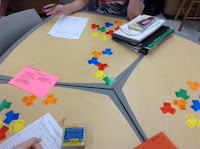
 My school is focusing on vocabulary instruction this year with the hope of increasing academic gains in several areas. To that end, I was asked to design an inservice with one of my colleagues for our staff to show how we could use blended learning tools to discretely teach vocabulary this year. Because my standard vocabulary approach had been to merely tell my students the meaning of a word and then keep teaching, I was surprised to be asked to lead this one. Still, I viewed it as a chance to learn something new and dove in. Last week completed the seventh session of this professional development that included an introduction to vocabulary instruction, a station rotation of Marzano strategies, and vocabulary centers.
My school is focusing on vocabulary instruction this year with the hope of increasing academic gains in several areas. To that end, I was asked to design an inservice with one of my colleagues for our staff to show how we could use blended learning tools to discretely teach vocabulary this year. Because my standard vocabulary approach had been to merely tell my students the meaning of a word and then keep teaching, I was surprised to be asked to lead this one. Still, I viewed it as a chance to learn something new and dove in. Last week completed the seventh session of this professional development that included an introduction to vocabulary instruction, a station rotation of Marzano strategies, and vocabulary centers.
Our first portion of the inservice introduced the idea of tiered vocabulary. We used Pear Deck to acquaint our peers with Tier 1, 2, and 3 vocabulary words. Tier 1 words are words the students come to us knowing. Tier 3 words are the content-specific words we already teach. Tier 2 words are powerful tweeners, the words that cross curricula, have multiple meanings, and provide a specificity in meaning. Our hope is that teachers will focus more of Tier 2 words this year.
 The second segment of our inservice was a station rotation where each participant was assigned a challenging word (pulchritude does not sound like what it means!) and then worked through a set of Marzano strategies to learn that word and many others. On slides, we wrote friendly definitions, chose images, wrote synonyms and antonyms, and had a conversation with these words. Then all the words we presented by participants. We finished with a game. For our game, we used Speed Match by SuperTeacherTools. Want to try your hand at this game or just see what speed match is? Check it out here. It was VERY easy to create!
The second segment of our inservice was a station rotation where each participant was assigned a challenging word (pulchritude does not sound like what it means!) and then worked through a set of Marzano strategies to learn that word and many others. On slides, we wrote friendly definitions, chose images, wrote synonyms and antonyms, and had a conversation with these words. Then all the words we presented by participants. We finished with a game. For our game, we used Speed Match by SuperTeacherTools. Want to try your hand at this game or just see what speed match is? Check it out here. It was VERY easy to create!Our third portion of the inservice allowed our colleagues a lot of flexibility in path, pace, and place as they explored our vocabulary centers. With ten different vocabulary tools at the centers, everyone had the opportunity to explore many strategies or focus on one in great detail. Overall, our inservice was well-received and our peers reported that they left with many ideas about what and how to teach vocabulary this year. Many people worried, though, that adding vocabulary instruction could take too much time, or at least take time away from something else.
In the category of "practice what you preach," I wanted to raise my vocabulary instruction without sacrificing too much time. Because I had never really done any vocabulary instruction before now, I acknowledge that anything would be better than my status quo. When it was time to review my first unit, I used a quick strategy to highlight some Tier 2 words from introductory chemistry. My students, working in pairs, were assigned a Tier 2 word. They had to write a sentence that showed how the word was used in chemistry, write a sentence that showed how the word might be used outside of chemistry, and then explain a similarity between the two sentences. They did this with dry erase markers on the glass walls in our media center. When they finished, they gallery walked the room and read all the sentences, putting stars next to the ones that they liked the best. Some of my favorites were the sentences and explanations of words like "element," "compound," "composition," and "uniform." The whole activity, from start to finish, took about ten minutes and I will definitely use this one again.




